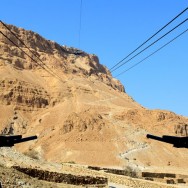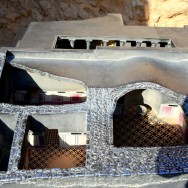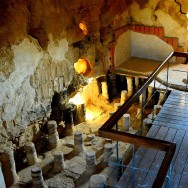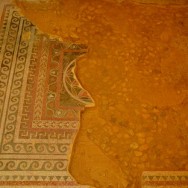Why would anyone build a fort at Masada I wondered; the climate is dry, the soil barren and the only source of water is that from the Dead Sea – which, believe me, doesn’t taste too well. But then, maybe the Geo-Political situation during those times were very different, and if one is prepared well enough one could make a desert livable.
As I have already mentioned and you can very well see too in the photos, the location where Masada stands is mostly un-inhabitable. But the Masada fort had been equipped with facilities which could withstand sieges from enemies for months together. Let’s see how!
The primary requirement of any fort is that it should be defensible: Masada has a 400m cliff on its east and a smaller 91m cliff on its west side; the natural approaches to the cliff top are very difficult. The top is flat and rhomboid-shaped, about 550m by 270m. There was a strong wall around the top of the plateau about 3.7m high, with many towers. There were three narrow, winding paths leading from below up to fortified gates.
The perimeter wall fortification

The black horizontal line on the wall depicts the level of the wall before restoration works in recent times.
Masada fortress was fully equipped to sustain a siege and had large storehouses, barracks, an armory, and cisterns that were refilled by rainwater.
A half intact Guard tower
Most of the fortifications at Masada was done by Herod the Great. Herod built palaces for himself on the mountain and fortified Masada between 37 and 31 BCE.
The following interesting excerpt depicts the Roman siege over Masada occupied by Jewish rebels during the First Jewish–Roman War (66–73 CE)
In 66 CE, a group of Jewish rebels, the Sicarii, overcame the Roman garrison of Masada with the aid of a ruse. After the destruction of the Second Temple in 70 CE, additional members of the Sicarii fled Jerusalem and settled on the mountaintop. In 73 CE, the Roman governor of Judaea Lucius Flavius Silva headed the Roman legion X Fretensis and laid siege to Masada. The Roman legion surrounded Masada, and built a circumvallation wall and then a siege ramp against the western face of the plateau. The ramp was complete in the spring of 73, after probably two to three months of siege, allowing the Romans to finally breach the wall of the fortress with a battering ram. Romans took the X Legion and a number of auxiliary units and Jewish prisoners of war, totalling some 15,000 troops in order to crush Jewish resistance at Masada. A giant siege tower with a battering ram was constructed and moved laboriously up the completed ramp. Originally, Jewish rebels on top of Masada threw stones at those building and constructing the ramp. When this plan was realized, the Romans put captured Jewish prisoners from previously conquered towns to work the ramp. The Jewish people on top of Masada stopped killing those who built the ramp, choosing not to kill their fellow Jews, even though they understood this might result in the Romans penetrating the fortress. The walls of the fortress were breached in 73 CE. According to Josephus, when Roman troops entered the fortress, they discovered that its 960 inhabitants had set all the buildings but the food storerooms ablaze and committed mass suicide or killed each other. Josephus wrote of two stirring speeches that the Sicarii leader had made to convince his fellows to kill themselves. Only two women and five children were found alive. Josephus presumably based his narration upon the field commentaries of the Roman commanders that were accessible to him. There are significant discrepancies between archaeological findings, and Josephus’ writings. Also, those many bodies have never been found at Masada which further raises questions on Josephus version of the siege. Wikipedia
The Roman attack ramp still stands on the western side and can be climbed on foot.
Herod, known for his architectural extravagance, was a Roman vassal king ruling over the Judaean empire, hence Masada had structures with predominant Roman style.
We entered the Masada National Park at around 11:30 and even after roaming around exploring for more than 4 hours we couldn’t do enough justice to the place so I do suggest a full day visit. During the visit remember to hydrate yourself constantly as there are no shelters and sun is blazing hot on the Masada plateau.
My Indian eyes welcomed the arid desert landscape and enjoyed the Roman style of architecture. I’m quite confident that if the Masada fort was intact it would’ve been a serious contender for one of wonders of the world.










